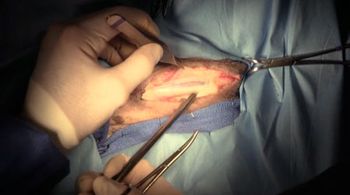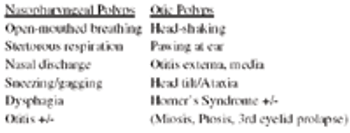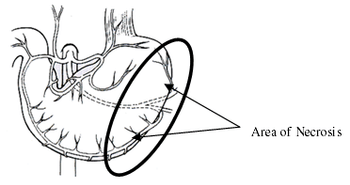
Dr. Don Waldron demonstrates this technique, which may be indicated in patients with life-threatening upper airway obstruction, trauma, neoplasia, or functional abnormality and in many other situations.
Dr. Waldron is the Chief Veterinary Medical Officer of the Western Veterinary Conference and teaches and produces hands-on training courses for veterinarians at the Oquendo Center in Las Vegas, Nevada in conjunction with the conference and throughout the year.

Dr. Don Waldron demonstrates this technique, which may be indicated in patients with life-threatening upper airway obstruction, trauma, neoplasia, or functional abnormality and in many other situations.

Dr. Don Waldron demonstrates this procedure, which is most often indicated in small animals for gastric foreign body removal or to obtain biopsy samples.

See how Dr. Don Waldron performs this procedure indicated for treating salivary mucoceles and, rarely, salivary gland neoplasia.

Dr. Don Waldron demonstrates this procedure, which is indicated in veterinary patients that may be anorectic postoperatively or are otherwise anorectic.

Dr. Don Waldron demonstrates his method of choice for this definitive treatment for dogs with GDV.

Male dogs suffering from recurrent urethral blockage due to urinary calculi may benefit from this procedure that permanently diverts urine flow.

Dr. Don Waldron demonstrates canine scrotal urethrostomy, with castration and scrotal ablation.

Urine diversion techniques are performed to temporarily or permanently divert urine from its normal anatomic course from the kidney through the ureter to the bladder and finally through the urethra. Veterinarians are most familiar with temporary urine diversion (urethral catheters) that are often used to stabilize animals that are sick as a result of metabolic changes associated with urinary tract obstruction.

Laryngeal paralysis is a congenital or acquired disease that causes upper airway obstruction. Paralysis causes partial or complete obstruction of the laryngeal lumen due to denervation of the cricoarytenoideus dorsalis muscle of the larynx. Interruption of nerve transmission from the recurrent laryngeal nerve or the vagus results in failure of the arytenoid cartilages and vocal folds to abduct on inspiration.

Megacolon occurs more frequently in cats than dogs and is usually seen in middle-aged to geriatric cats. The ascending, transverse, and descending colon are chronically large in diameter and filled with dry stool. A congenital form of the disease has been seen especially in Manx cats with rectal/anal atresia and a sacral spinal deformity.

Careful consideration of preoperative, intraoperative, and postoperative management techniques will assist in preventing complications related to anesthesia and surgery in patients with urinary tract surgical disease. Hospital acquired renal insufficiency is common in humans, seemingly less so in animals but caution is advised. Hypotension of any cause is a potential predisposing cause to renal failure.

Tube drainage of the thorax is indicated to drain free air or fluid in the pleural space. This is not an absolute indication as small amounts of air within the thorax do not require a thoracostomy tube. Similarly, the presence of blood within the pleural space is not usually an indication for thoracic drainage.

Urine diversion techniques are performed to temporarily or permanently divert urine from its normal anatomic course from the kidney through the ureter to the bladder and finally through the urethra. Veterinarians are most familiar with temporary urine diversion (urethral catheters) that are often used to stabilize animals that are sick as a result of metabolic changes associated with urinary tract obstruction. Temporary diversion (peritoneal drainage) may also be used as a bridge to more definitive surgical procedures such as repair of a ruptured urinary bladder.

Laryngeal paralysis is a congenital or acquired disease that causes upper airway obstruction. Paralysis causes partial or complete obstruction of the laryngeal lumen due to denervation of the cricoarytenoideus dorsalis muscle of the larynx. Interruption of nerve transmission from the recurrent laryngeal nerve or the vagus results in failure of the arytenoid cartilages and vocal folds to abduct on inspiration.

Megacolon occurs more frequently in cats than dogs and is usually seen in middle-aged to geriatric cats. The ascending, transverse, and descending colon are chronically large in diameter and filled with dry stool. A congenital form of the disease has been seen especially in Manx cats with rectal/anal atresia and a sacral spinal deformity. An acquired form of the disease has been seen secondary to mechanical obstruction caused by malunion of pelvic fractures that have not had surgical treatment.

Careful consideration of preoperative, intraoperative, and postoperative management techniques will assist in preventing complications related to anesthesia and surgery in patients with urinary tract surgical disease. Hospital acquired renal insufficiency is common in humans, seemingly less so in animals but caution is advised. Hypotension of any cause is a potential predisposing cause to renal failure.

Surgical exploration of the abdomen is performed for diagnostic, therapeutic, and prognostic purposes.

There are many causes of upper airway disease in the cat.

Laryngeal paralysis is a congenital or acquired disease that causes upper airway obstruction.

Urine diversion techniques are performed to temporarily or permanently divert urine from its normal anatomic course from the kidney through the ureter to the bladder and finally through the urethra.

Megacolon occurs more frequently in cats than dogs and is usually seen in middle-aged to geriatric cats.

Layers of the intestinal wall include mucosa, submucosa, muscularis, and serosa.

Disease of the ears is very common in both dogs and cats.

Surgical exploration of the abdomen is performed for diagnostic, therapeutic, and prognostic purposes.

Axial pattern flaps (APF) are a type of pedicle flap that include a large direct cutaneous artery and vein.

Layers of the intestinal wall include mucosa, submucosa, muscularis, and serosa.

Normal Anatomy: The stomach is divided into the cardia, fundus, body, and pyloric antrum and the esophagus enters the stomach through the cardiac ostium.

The prevalence of renal and/or ureteral calculi in the dog is relatively uncommon (5-10% of all urinary tract calculi) when compared to calculi in the lower urinary tract.

Avoiding surgical mistakes begins before surgery with appropriate workup of each case on an individual basis.

Axial pattern flaps (APF) are a type of pedicle flap that include a large direct cutaneous artery and vein.

Published: November 1st 2010 | Updated:

Published: November 1st 2010 | Updated:

Published: November 1st 2010 | Updated:

Published: November 1st 2010 | Updated:

Published: August 1st 2010 | Updated:

Published: August 1st 2010 | Updated: